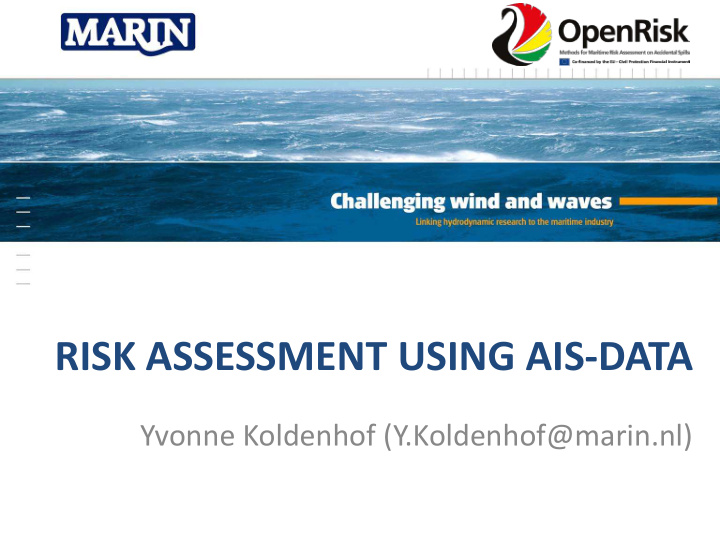



RISK ASSESSMENT USING AIS-DATA Yvonne Koldenhof (Y.Koldenhof@marin.nl)
AIS – INTRODUCTION – RISK ASSESSMENT How to use AIS-data in Risk Assessment? 1. Validate and create necessary traffic databases/information that can be used in already existing risk assessment models 2. Analysis of encounter situations / near-miss 3. Dynamic risk analysis (risk index) 4. Analysis of the risk for an offshore pipeline/cable due to shipping 5. ….. 2
AIS – INTRODUCTION – EXAMPLES OF AIS-ANALYSIS Behavior of ship at anchor Behavior of vessels around a windfarm Encounter situation in a port aera (swept-path analysis) 3
NEAR-MISS ANALYSIS • Based on AIS-data MARIN has developed a method to identify encounter and near-miss situation at the North Sea. • This method is based on calculating CPA/TCPA/Distance between ships • An overview of the number of encounters and near-misses provides information regarding potential high risk areas at sea. 4
RISK INDEX; DEFINITION Risk index: calculated value for each individual ship indicating the average risk of the ship at that moment. Risk = Probability * Consequences Probability expected probability of an accident when a ship will be present at the given location (AIS) taking into account different given factors; Consequences expected consequences given an accident (in this case the expect amount of oil (or chemical) spill); 5
RISK INDEX: FREQUENCY MODEL • EXP : Exposure for a certain accident type (i), e.g. encounter • CASRAT : Casualty rate for a certain accident type (i) for a certain type of ship and shipsize P accident ( i ) = EXP( i ) * CASRAT( i, type, size ) • F flag = multiplication factor for flag state (Port State Control List) • F age = multiplication factor for age of the ship • F wind = multiplication factor for wind • F vis = multiplication factor for visibility • F nav = multiplication factor for navigational status P accident ( i ) = F flag * F age * F wind * F vis * F nav * EXP( i ) * CASRAT( i, type, size ) 6
RISK INDEX: FREQUENCY MODEL • Exposures : possible dangerous situation given the present traffic situation, area layout and environmental conditions. Accident type Exposure Based on average number of Collision Encounter encounters in an area Foundering Nautical miles Based on CPA and TCPA, (taken from Hull failure Nautical miles AIS-analysis, near-miss studies) Machinery failure Nautical miles Fire/Explosions Nautical miles Based on domain penetration method….. Ramming contact Ramming Opportunity Drifting contact Stranding Opportunity 7
RISK INDEX: CONSEQUENCE MODELLING Consequences expected consequences given an accident 1. Loss of life 2. Pollution: environmental damage (oil spill) Expected amount of oil spill 3. Structural damage 8
RISK INDEX; CONSEQUENCE MODELING (POLLUTION) 10
RISK INDEX; CONSEQUENCE MODELING (POLLUTION) 11
RISK INDEX; TOTAL MODEL • DEMO 12
RISK INDEX; TOTAL MODEL • Risk Value = RI_LoL + RI_Polution + RI_Structural 13
RISK INDEX: EXAMPLES OF THE USE 14
CONCLUSION AND FURTHER WORK • An approach using AIS and a “real-time” risk calculation can provided insight in the present situation, but also provide insight in certain “hot-spots” and the change of risk in an area over time. • The “model” is still (and will always be) a “living” model/approach, depending on the available data or depending on the propose, level of detail necessary… • Work in OpenRisk: • Research on the encounter model Provide demonstration for the Baltic Sea are • 15
Recommend
More recommend